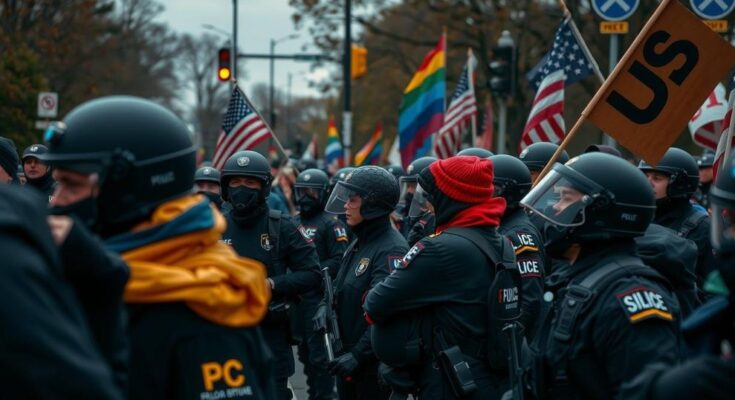Human rights organizations urge U.S. universities to enhance protections for student demonstrators, particularly those advocating for Palestine. An open letter cites police violence during protests, highlighting excessive use of force and its threat to free speech. The letter identifies 20 universities for further investigation and calls for policy changes that prioritize peaceful protest over coercive police action.
Human rights organizations, including the ACLU and Amnesty International, implore universities across the U.S. to safeguard students’ rights to protest, particularly regarding pro-Palestine demonstrations. Their open letter expresses grave concern over the rise in police violence during these events, highlighting that excessive use of force jeopardizes freedoms of speech and assembly. Incidents involve heavily armored police deploying physical force, including batons and chemical irritants like pepper spray, during student protests. The letter identifies 20 universities meriting further review for incidents of excessive police force against student demonstrators, including notable schools like UCLA and Columbia. Amnesty International is still actively researching other campuses to ensure students are protected during protests. Kirsten Bokenkamp from Amnesty expressed that despite Ohio State not being on their initial list, ongoing investigations into similar issues are in progress. Jineen Musa, co-president of Students for Justice in Palestine at Ohio State, criticized the university’s handling of protests, citing a specific incident that showcased the administration’s readiness to curtail free expression. After a protest on April 25 resulted in numerous arrests, Musa condemned the extreme measures taken against demonstrators, calling attention to the aggressive police response. Ben Johnson, a university spokesperson, defended the actions of law enforcement, clarifying that the demonstrations led to rule violations surrounding camping regulations. The university maintains that the protesters had ample opportunity to express their rights before being instructed to disperse, painting a picture of lawfulness amidst the chaos. The letter underscores universities’ human rights obligations, urging leaders to formulate policies that uphold students’ rights to protest peacefully. It emphasizes reducing police interventions and employing them strictly as a last resort, stressing that coercive measures can exacerbate safety risks rather than diminish them. Calls for ensuring police do not employ force to break up protests are made clearly, noting that such actions can escalate tensions rather than resolve conflicts. Furthermore, the letter advocates for open lines of communication between university administrators and protest organizers to safeguard students and promote peaceful demonstrations. Lastly, the letter urges a commitment to impartiality regarding the handling of protests, asserting that police presence should not depend on the desirability of the protest in the eyes of the university. It encourages institutions to continuously evaluate their policies for alignment with international human rights standards, ensuring an environment conducive to freedom of speech. Both Musa and Johnson articulated contrasting perspectives on Ohio State’s approach, with Musa lamenting the prioritization of corporate interests over basic student rights, while Johnson emphasized the university’s dedication to maintaining a balance between free speech and campus order.
The ongoing tensions regarding students’ rights to protest, especially in relation to pro-Palestinian demonstrations, have provoked a significant response from several human rights organizations. Their collective advocacy aims to ensure that educational institutions foster an environment where free speech and peaceful assembly thrive without undue interference from law enforcement. Understanding the implications of police actions during these protests is crucial for addressing broader human rights concerns associated with academic freedom and student safety.
In summary, the open letter from human rights groups advocates for a commitment from U.S. universities to protect students’ rights to protest while minimizing police intervention. It highlights the need for a balanced approach that upholds free speech without resorting to excessive force. As discussions continue about the appropriate handling of campus protests, ensuring safety and respecting students’ rights remains paramount.
Original Source: www.thelantern.com



